Land Expansion and Green Rural Transformation in Developing Countries: A Kaya Identity Approach
Abstract
1. Introduction
2. Materials and Methods
3. Results
3.1. Correlations with GDP per Capita
3.2. Trends in Key Components of the Land Identity
4. Discussion
4.1. Policy Implications
4.2. Limitations
5. Conclusions
Funding
Institutional Review Board Statement
Informed Consent Statement
Data Availability Statement
Conflicts of Interest
References
- Berdegué, J.; Rosada, T.; Bebbington, A. The rural transformation. In International Development Ideas, Experience and Prospects; Currie-Alder, B., Kanbur, R., Malone, D., Medhora, R.R., Eds.; Oxford University Press: Oxford, UK; New York, NY, USA, 2014; pp. 463–478. [Google Scholar]
- Barbier, E.B. Is green rural transformation possible in developing countries? World Dev. 2020, 131, 104955. [Google Scholar] [CrossRef]
- Barbier, E.B. Greening agriculture for rural development. World Dev. 2025, 191, 106974. [Google Scholar] [CrossRef]
- Barrett, C.B.; Ortiz-Bobea, A.; Pham, T. Structural transformation, agriculture, climate, and the environment. Rev. Environ. Econ. Policy 2023, 17, 195–216. [Google Scholar] [CrossRef]
- Mallawaarachchi, T.; Rahut, D.B. Realising rural economic transformation: Pathways to inclusive and sustainable prosperity in post-COVID-19 Asia. Econ. Anal. Policy 2023, 77, 1076–1082. [Google Scholar] [CrossRef] [PubMed]
- Rahman, A.; Rosandi, V.B.; Indraprahasta, G.S.; Prasetyadi, A.; Saputra, A.Y.; Pravitasari, A.E. Rural transformation research: Current state, dynamics, and future directions. Area 2025, e70049. [Google Scholar] [CrossRef]
- Silva, J.M.C.; Araujo, L.S.; Torres, R.R.; Barbosa, L.C.F. The sustainability of development pathways and climate change vulnerability in the Americas. Ecol. Econ. 2024, 220, 108164. [Google Scholar] [CrossRef]
- International Labor Organization (ILO). Sectoral Policies for a Just Transition; Just Transition Policy Brief; ILO: Geneva, Switzerland, 2022. [Google Scholar]
- Christiaensen, L.; Martin, W. Agriculture, structural transformation and poverty reduction: Eight new insights. World Dev. 2018, 109, 413–416. [Google Scholar] [CrossRef]
- Ligon, E.; Sadoulet, E. Estimating the relative benefits of agricultural growth on the distribution of expenditures. World Dev. 2018, 109, 417–428. [Google Scholar] [CrossRef]
- Organization for Economic Cooperation and Development (OECD); Food and Agricultural Organization (FAO). OECD-FAO Agricultural Outlook 2024–2033; OECD: Paris, France, 2024. [Google Scholar] [CrossRef]
- Busch, J.; Ferretti-Gallon, K. What drives and stops deforestation, reforestation, and forest degradation? An updated meta-analysis. Rev. Environ. Econ. Policy 2023, 17, 217–250. [Google Scholar] [CrossRef]
- Damania, R.; Balseca, E.; De Fontaubert, C.; Gill, J.; Rentschler, J.; Russ, J.; Zaveri, E. Detox Development: Repurposing Environmentally Harmful Subsidies; World Bank: Washington, DC, USA, 2023. [Google Scholar]
- Gallardo, R.K. The environmental impacts of agriculture: A review. Int. Rev. Environ. Resour. Econ. 2024, 18, 165–235. [Google Scholar] [CrossRef]
- Pendrill, F.; Gardner, T.A.; Meyfroidt, P.; Persson, U.M.; Adams, J.; Azevedo, T.; Bastos Lima, M.G.; Baumann, M.; Curtis, P.G.; De Sy, V.; et al. Disentangling the numbers behind agriculture-driven tropical deforestation. Science 2022, 377, eabm9267. [Google Scholar] [CrossRef] [PubMed]
- Winkler, K.; Fuchs, R.; Rounsevell, M.; Herold, M. Global land use changes are four times greater than previously estimated. Nat. Commun. 2021, 12, 2501. [Google Scholar] [CrossRef] [PubMed]
- Winkler, K.; Fuchs, R.; Rounsevell, M.; Herold, M. Six decades of global crop yield increase and cropland expansion from 1960 to 2020. Environ. Res. Commun. 2025, 7, 055013. [Google Scholar] [CrossRef]
- Kaya, Y. The role of CO2 removal and disposal. Energy Convers. Manag. 1995, 36, 375–380. [Google Scholar] [CrossRef]
- Fankhauser, S.; Jotzo, F. Economic growth and development with low-carbon energy. Wiley Interdiscip. Rev. Clim. Change 2018, 9, e495. [Google Scholar] [CrossRef]
- Barbier, E.B. Water and economic growth in developed and developing countries. Water Econ. Policy 2024, 10, 2430002. [Google Scholar] [CrossRef]
- Organization for Economic Cooperation and Development (OECD). Agricultural Policy Monitoring and Evaluation 2023: Adapting Agriculture to Climate Change Mitigation; OECD: Paris, France, 2023; Available online: https://www.oecd-ilibrary.org/agriculture-and-food/agricultural-policy-monitoring-and-evaluation-2023_b14de474-en (accessed on 23 October 2025).
- Food and Agricultural Organization (FAO). The State of Food and Agriculture 2023—Revealing the True Cost of Food to Transform Agrifood Systems; FAO: Rome, Italy, 2023. [Google Scholar] [CrossRef]
- Gautam, M.; Laborde, D.; Mamun, A.; Martin, W.; Piñeiro, V.; Vos, R. Repurposing Agricultural Policies and Support: Options to Transform Agriculture and Food Systems to Better Serve the Health of People, Economies, and the Planet; World Bank and IFPRI: Washington, DC, USA, 2022. [Google Scholar]
- Laborde, D.; Mamun, A.; Martin, W.; Piñeiro, V.; Vos, R. Agricultural subsidies and global greenhouse gas emissions. Nat. Commun. 2021, 12, 2601. [Google Scholar] [CrossRef]
- Rosegrant, M.W.; Sulser, T.B.; Wiebe, K. Global investment gap in agricultural research and innovation to meet Sustainable Development Goals for hunger and Paris Agreement climate change mitigation. Front. Sustain. Food Syst. 2022, 6, 965767. [Google Scholar] [CrossRef]
- Belton, B.; Baldiga, L.; Justice, S.; Minten, B.; Narayanan, S.; Reardon, T. Can the global drone revolution make agriculture more sustainable? Science 2025, 389, 972–976. [Google Scholar] [CrossRef]
- Davis, B.; de la O Campos, A.P.; Farrae, M.; Winters, P. Whither the agricultural productivity-led model? Reconsidering resilient and inclusive rural transformation in the context of agrifood systems. Glob. Food Secur. 2024, 43, 100812. [Google Scholar] [CrossRef]
- Dong, W.; Chunlai, C. A review of rural transformation studies: Definition, measurement, and indicators. J. Integr. Agric. 2023, 22, 3568–3581. [Google Scholar] [CrossRef]
- De Janvry, A.; Sadoulet, E. Seven Propositions to Support and Finance the Agricultural Sector in Sub-Saharan Africa in the Context of Climate Change. In FERDI Working Paper; Fondation pour les Études et Recherches sur le Développement International: Clermont-Ferrand, France, 2023; Available online: https://hal.science/hal-04123941v1 (accessed on 11 November 2025).
- Beduschi, L.C.; Faret, P.; Hadad, M.I. Inclusive rural transformations in Latin America—Reassessing and planning under pressures and constraints. In FAO Inclusive Agrifood Systems Working Papers; No. 2; FAO: Rome, Italy, 2025. [Google Scholar] [CrossRef]
- Barbier, E.B. The policy challenges of green rural transformation for Asia-Pacific emerging and developing economies in a post-COVID world. Econ. Anal. Policy 2020, 75, 689–704. [Google Scholar] [CrossRef]
- Azhgaliiyeva, D.; Rahut, D.B.; Sonobe, T. (Eds.) Strategies for Climate Resilience and Equity in Developing Asia and the Pacific; Asian Development Bank Institute: Tokyo, Japan, 2025. [Google Scholar] [CrossRef]
- Barbier, E.B.; Burgess, J.C. Economics of water scarcity and efficiency. Sustainability 2024, 16, 8550. [Google Scholar] [CrossRef]
- Meyfroidt, P.; Abeygunawardane, D.; Baumann, M.; Bey, A.; Buchadas, A.; Chiarella, C.; Junquera, V.; García, A.K.; Kuemmerle, T.; le Polain de Waroux, Y.; et al. Explaining the emergence of land-use frontiers. R. Soc. Open Sci. 2024, 11, 240295. [Google Scholar] [CrossRef] [PubMed]
- Barbier, E.B. Scarcity, frontiers and development. Geogr. J. 2012, 178, 110–122. [Google Scholar] [CrossRef]
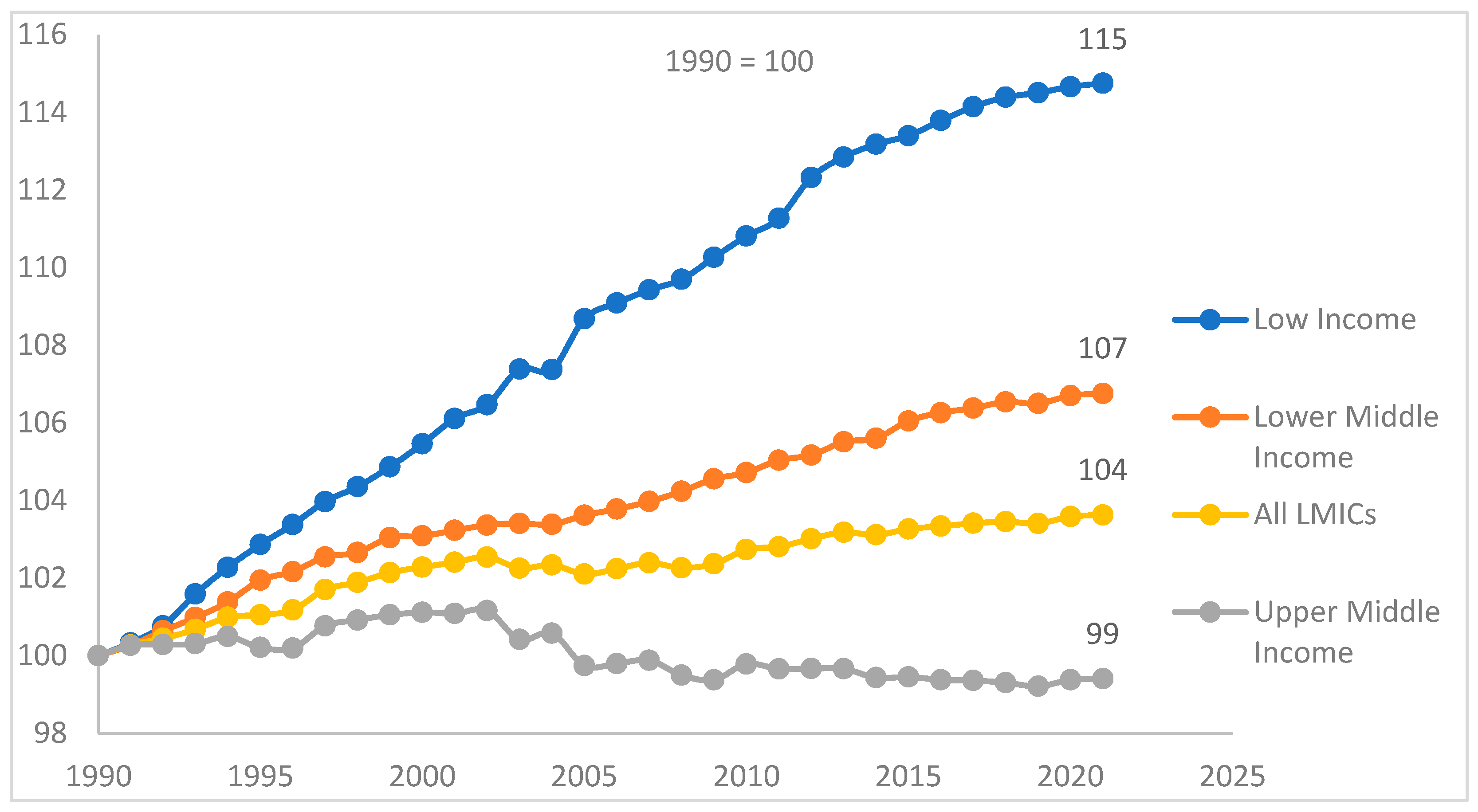
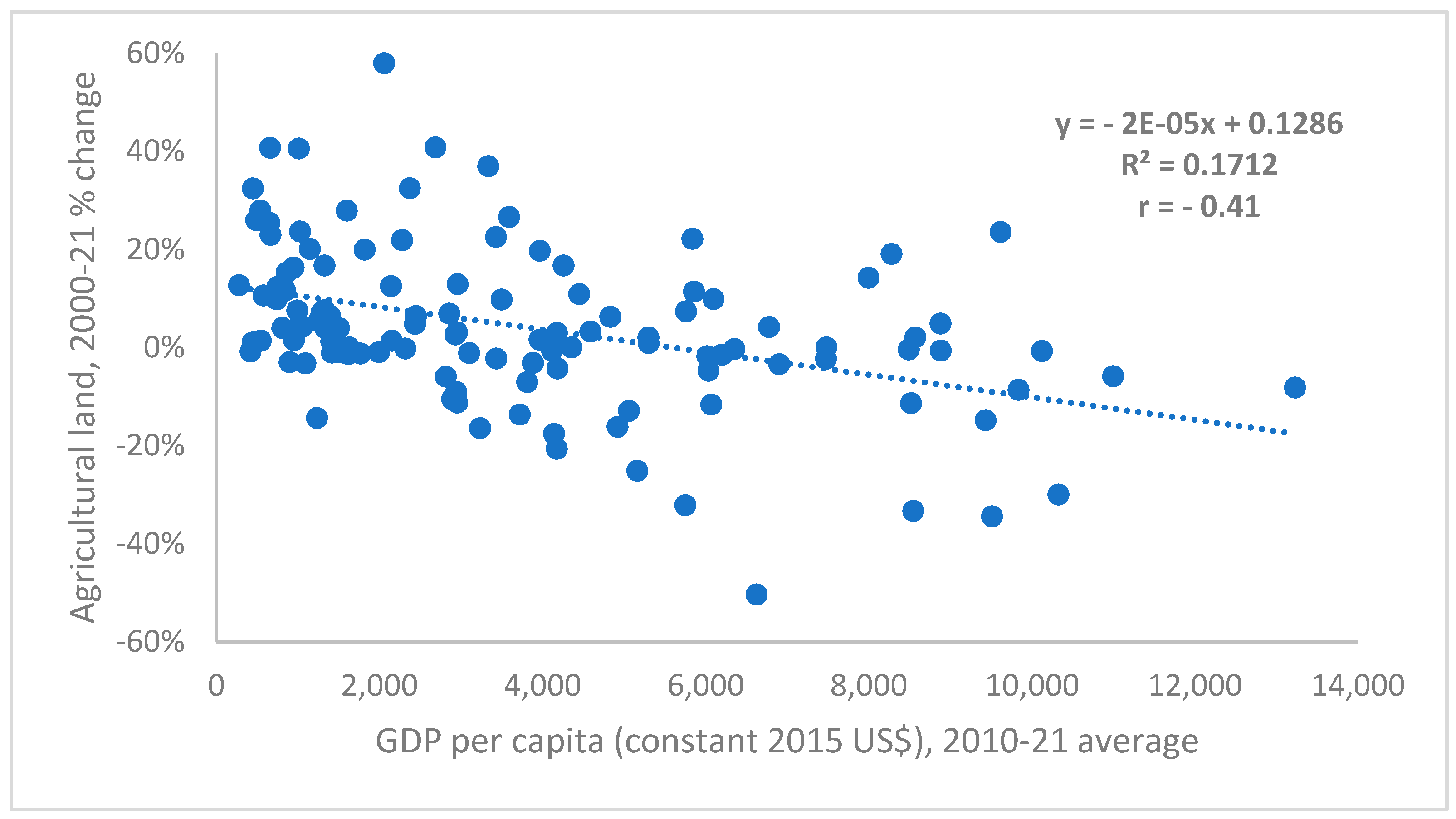
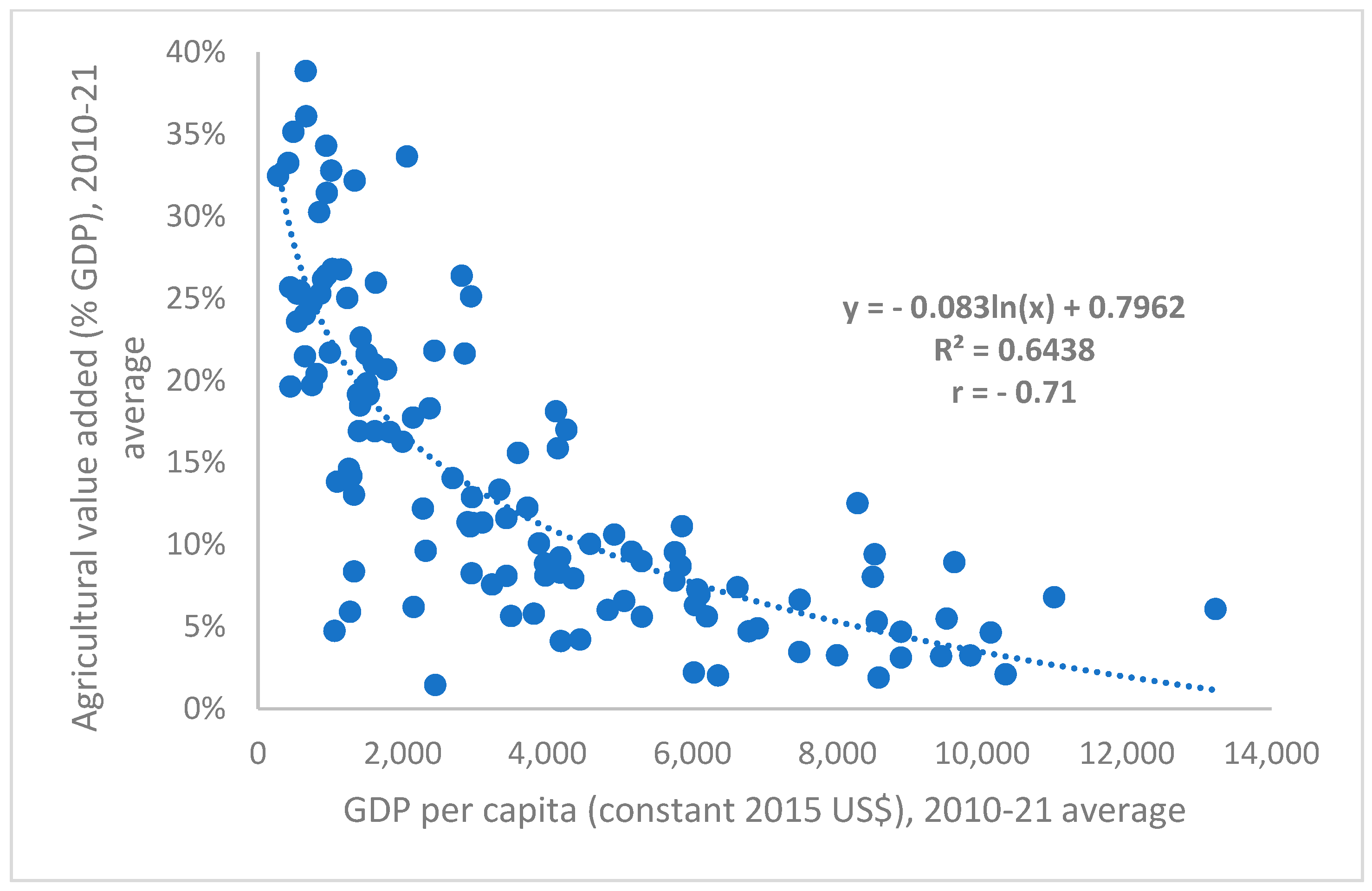
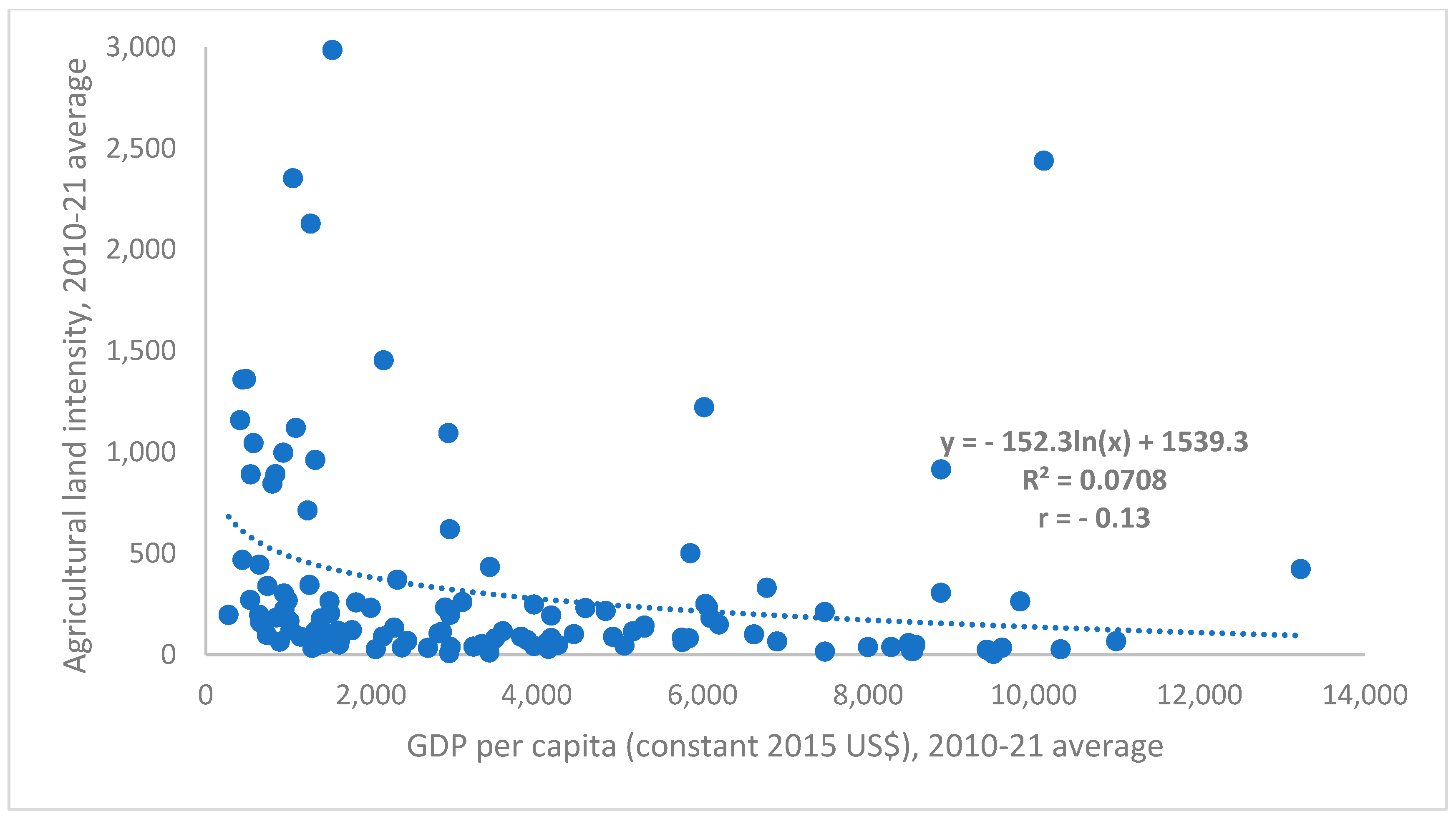

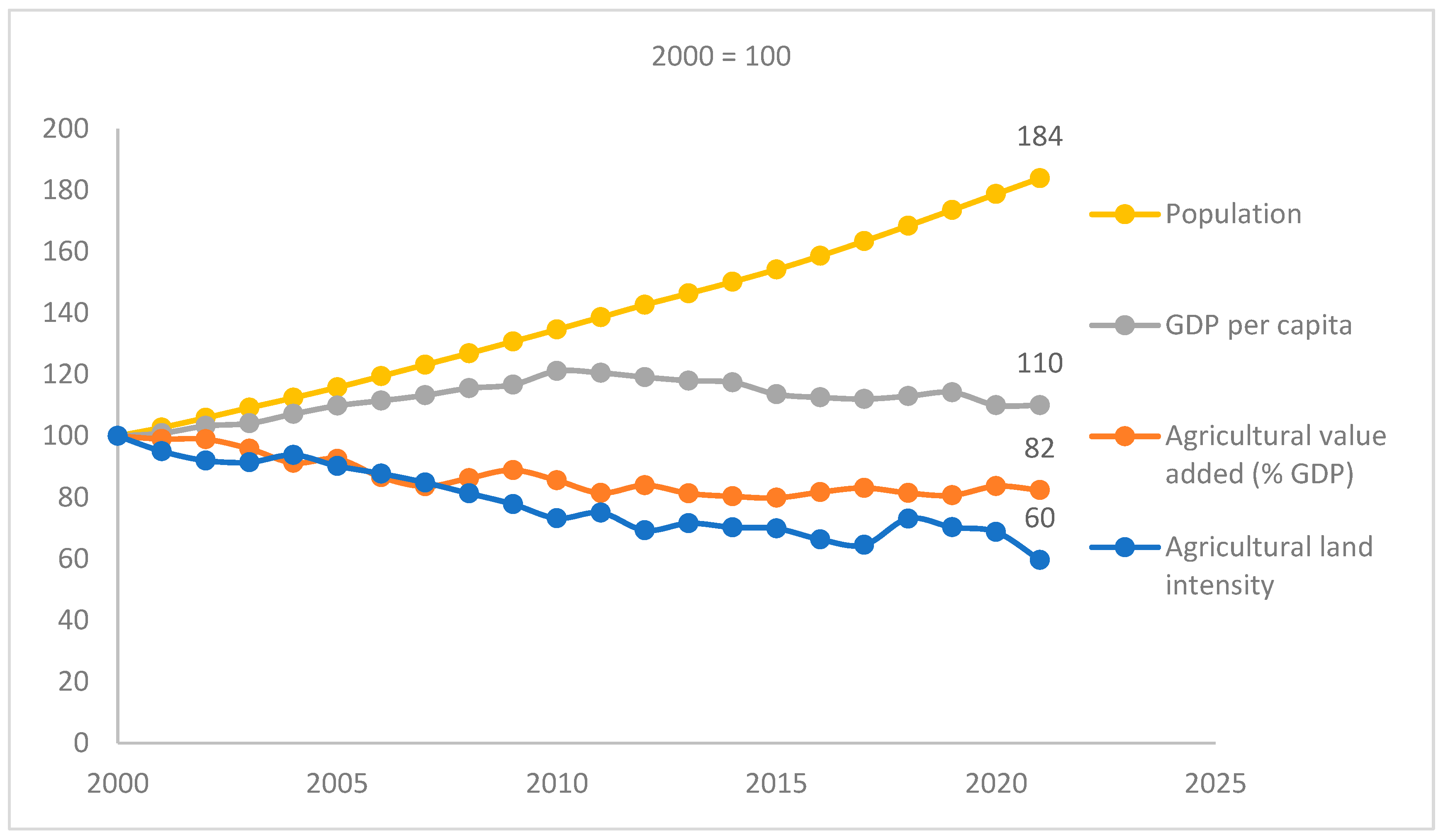
| Income Group | Agricultural Land Intensity | Agricultural Value Added (% GDP) | GDP per Capita | Population (Millions) |
|---|---|---|---|---|
| 2000–2002 Average | ||||
| Low | 762 | 33.8 | 637 | 290.0 |
| Lower Middle | 737 | 20.1 | 1581 | 2169.2 |
| Upper Middle | 939 | 10.0 | 4475 | 2380.9 |
| All LMICs | 826 | 18.2 | 2628 | 4840.1 |
| 2019–2021 Average | ||||
| Low | 528 | 28.0 | 700 | 503.8 |
| Lower Middle | 467 | 15.7 | 2323 | 2967.8 |
| Upper Middle | 472 | 7.8 | 6589 | 2775.2 |
| All LMICs | 479 | 14.5 | 3827 | 6246.7 |
| % Change 2000–2002 to 2019–2021 | ||||
| Low | −30.8% | −17.2% | 9.9% | 73.7% |
| Lower Middle | −36.6% | −21.8% | 47.0% | 36.8% |
| Upper Middle | −49.8% | −22.1% | 47.2% | 16.6% |
| All LMICs | −41.9% | −20.4% | 45.6% | 29.1% |
| Region | Agricultural Land Intensity | Agricultural Value Added (% GDP) | GDP per Capita | Population (Millions) |
|---|---|---|---|---|
| 2000–2002 Average | ||||
| East Asia and the Pacific | 1017 | 22.1 | 2345 | 1812.2 |
| Europe and Central Asia | 581 | 16.8 | 2509 | 212.9 |
| Latin America and Caribbean | 293 | 9.2 | 4875 | 469.4 |
| Middle East and North Africa | 789 | 9.4 | 3603 | 293.5 |
| South Asia | 230 | 23.3 | 1688 | 1439.7 |
| Sub-Saharan Africa | 1223 | 23.3 | 1535 | 612.4 |
| 2019–2021 Average | ||||
| East Asia and the Pacific | 342 | 16.2 | 4046 | 2094.8 |
| Europe and Central Asia | 330 | 10.1 | 5377 | 241.8 |
| Latin America and Caribbean | 171 | 8.2 | 6388 | 577.8 |
| Middle East and North Africa | 391 | 11.3 | 3917 | 418.4 |
| South Asia | 143 | 16.5 | 2958 | 1894.5 |
| Sub-Saharan Africa | 846 | 19.2 | 1974 | 1019.5 |
| % Change 2000–2002 to 2019–2021 | ||||
| East Asia and the Pacific | −66.4% | −26.6% | 72.5% | 15.6% |
| Europe and Central Asia | −43.2% | −39.8% | 114.3% | 13.6% |
| Latin America and Caribbean | −41.4% | −10.5% | 31.0% | 23.1% |
| Middle East and North Africa | −50.5% | 20.1% | 8.7% | 42.6% |
| South Asia | −37.9% | −29.4% | 75.2% | 31.6% |
| Sub-Saharan Africa | −30.8% | −17.7% | 28.6% | 66.5% |
Disclaimer/Publisher’s Note: The statements, opinions and data contained in all publications are solely those of the individual author(s) and contributor(s) and not of MDPI and/or the editor(s). MDPI and/or the editor(s) disclaim responsibility for any injury to people or property resulting from any ideas, methods, instructions or products referred to in the content. |
© 2025 by the author. Licensee MDPI, Basel, Switzerland. This article is an open access article distributed under the terms and conditions of the Creative Commons Attribution (CC BY) license (https://creativecommons.org/licenses/by/4.0/).
Share and Cite
Barbier, E.B. Land Expansion and Green Rural Transformation in Developing Countries: A Kaya Identity Approach. Land 2025, 14, 2314. https://doi.org/10.3390/land14122314
Barbier EB. Land Expansion and Green Rural Transformation in Developing Countries: A Kaya Identity Approach. Land. 2025; 14(12):2314. https://doi.org/10.3390/land14122314
Chicago/Turabian StyleBarbier, Edward B. 2025. "Land Expansion and Green Rural Transformation in Developing Countries: A Kaya Identity Approach" Land 14, no. 12: 2314. https://doi.org/10.3390/land14122314
APA StyleBarbier, E. B. (2025). Land Expansion and Green Rural Transformation in Developing Countries: A Kaya Identity Approach. Land, 14(12), 2314. https://doi.org/10.3390/land14122314








